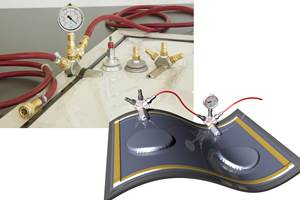AMRC adds 3D permeability measurement bench
The system is capable of measuring the permeability of a dry reinforcement, which is important for understanding how liquid resin will behave when injected in infusion and RTM processes.
The University of Sheffield Advanced Manufacturing Research Centre (AMRC, Sheffield, UK) has announced the addition of a 3D-permeability measurement bench to its diverse and growing portfolio of equipment. The new equipment was purchased with funding from the Aerospace Technology Institute (ATI,Cranfield, Bedfordshire, UK).
The EASYPERM permeability bench is manufactured by Institut de Soudure (Villepinte, France), an international technical center specializing in long fiber reinforced composites, and allows for the standardization of testing.
The system is capable of measuring the permeability of a dry reinforcement, which is important for understanding how liquid resin will behave when injected in infusion and RTM processes.
Steffan Lea, a research fellow at the AMRC Composite Centre, says, “What we get at the end is a measurement – a number that can be used in simulations that take a couple of minutes rather than several hours compared with if we were using other methods. By using sub-scale (coupons and computer simulation) testing to provide fast and accurate data, it cuts down on a trial and error approach, saving our research partners money, material and time.”
The system allows for the characterization of resin flow in dry fiber reinforcements – crucial information for performing simulations of large and complex parts, and also for process optimization in high production rates. It can be used to characterize all types of fiber including glass, carbon, aramid, flax and hemp and requires a minimal amount of material to perform the evaluation.
“Some of the key technical capabilities of the machine is that is has two configurations for permeability measurement – in-plane and through-thickness,” says Lea. “It has up to five bar injection pressure and is coupon scale so you’re not wasting lots of material while you’re doing the testing, making efficient use of test material. It also works with any kind of fiber and the chamber is adjustable so we can vary the fiber volume fraction.”
The permeability bench has already been used on projects including testing for GE Aviation’s Digital Propulsion project and FabForm, a project for a textile manufacturer looking at the stabilization of thick 3D woven fabric to create composite preforms for automotive and aerospace.
Lea explains how the machine works:
“Under the lid is a test chamber, inside which goes the test material – the coupon. You close the lid and inject a model fluid to replicate the resin – we use rapeseed oil - and as the pressure sensors inside the chamber are triggered, you can see how the oil flows through the material – so whether it flows in one direction more than another.
“A key factor for us is that EASYPERM is a commercially available piece of equipment so we can compare our results to others using the same methods and have certainty that the test is being conducted in a consistent manner. It is standardizing testing.
“In composites, there is a tendency for people to develop their own in-house way of testing but with this it is standardized. What that means is that if a university in Australia for example has the same equipment, we could compare our results with theirs, whereas before we would have to get our own material and do the tests in our own way.”
The new stable of ATI-funded equipment, which includes a braiding system, Jacquard loom, tailored fiber placement, a high temperature, high tension filament winder, tow-spreading machine and robotic end effectors for automated handling, will be used to not only manufacture preforms but also develop enabling technology for commercialization including joining, automation and impregnation. Research undertaken with this equipment by the AMRC aims to bring down the cost of complex composite components.
Related Content
MFFD thermoplastic floor beams — OOA consolidation for next-gen TPC aerostructures
GKN Fokker and Mikrosam develop AFP for the Multifunctional Fuselage Demonstrator’s floor beams and OOA consolidation of 6-meter spars for TPC rudders, elevators and tails.
Read MoreCompPair adds swift prepreg line to HealTech Standard product family
The HealTech Standard product family from CompPair has been expanded with the addition of CS02, a swift prepreg line.
Read MoreNovel composite technology replaces welded joints in tubular structures
The Tree Composites TC-joint replaces traditional welding in jacket foundations for offshore wind turbine generator applications, advancing the world’s quest for fast, sustainable energy deployment.
Read MoreSmartValves offer improvements over traditional vacuum bag ports
Developed to resolve tilting and close-off issues, SmartValves eliminate cutting through vacuum bags while offering reduced process time and maintenance.
Read MoreRead Next
Developing bonded composite repair for ships, offshore units
Bureau Veritas and industry partners issue guidelines and pave the way for certification via StrengthBond Offshore project.
Read More“Structured air” TPS safeguards composite structures
Powered by an 85% air/15% pure polyimide aerogel, Blueshift’s novel material system protects structures during transient thermal events from -200°C to beyond 2400°C for rockets, battery boxes and more.
Read MorePlant tour: Daher Shap’in TechCenter and composites production plant, Saint-Aignan-de-Grandlieu, France
Co-located R&D and production advance OOA thermosets, thermoplastics, welding, recycling and digital technologies for faster processing and certification of lighter, more sustainable composites.
Read More














.jpg;maxWidth=300;quality=90)











